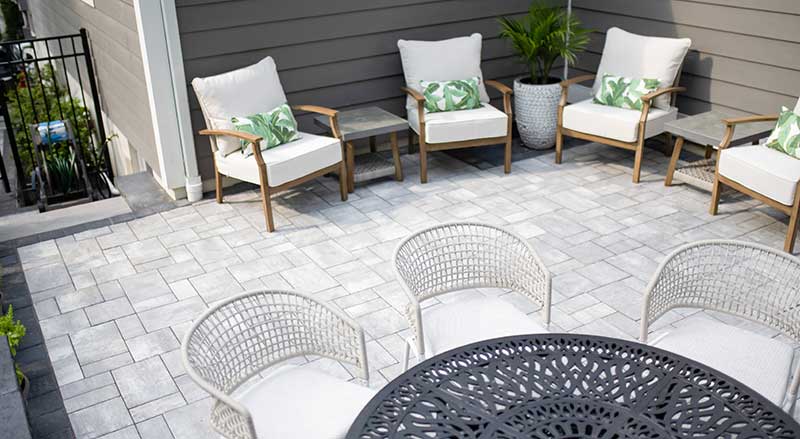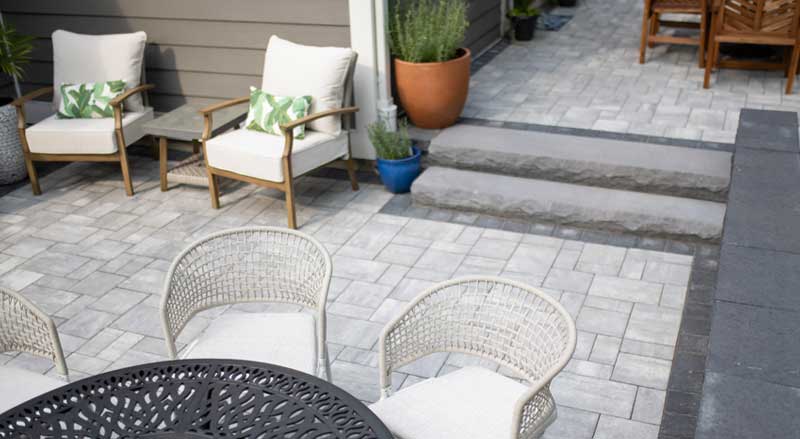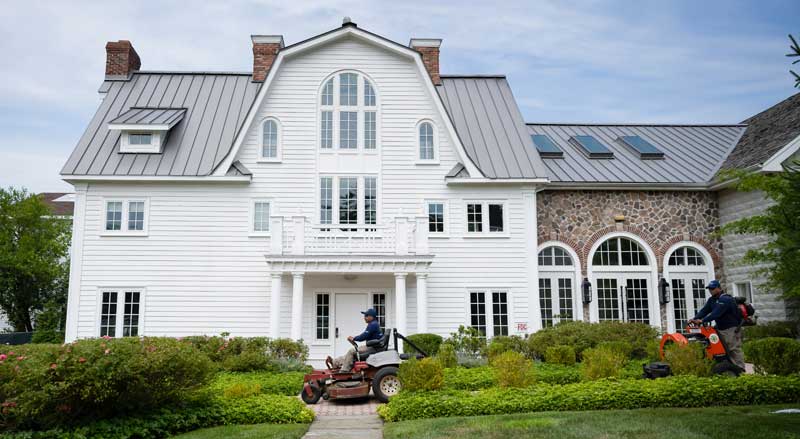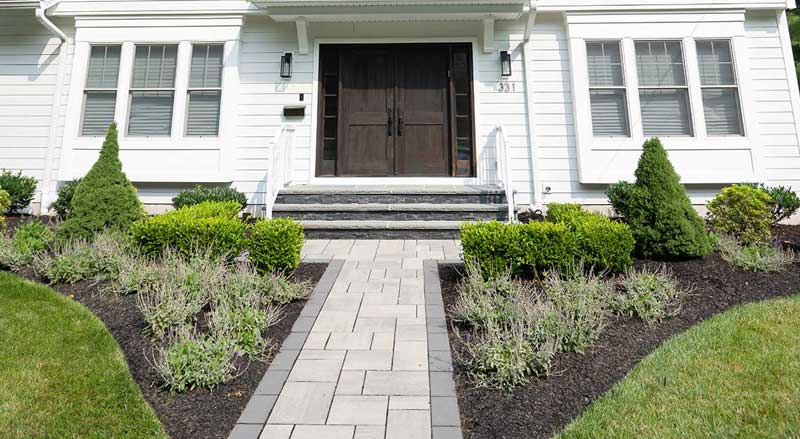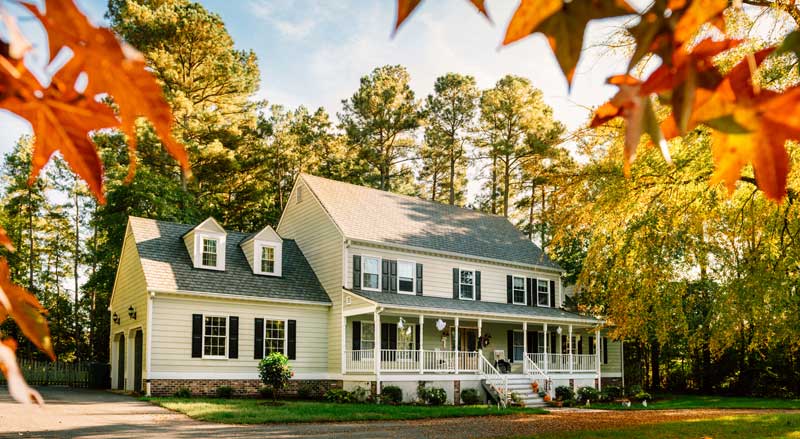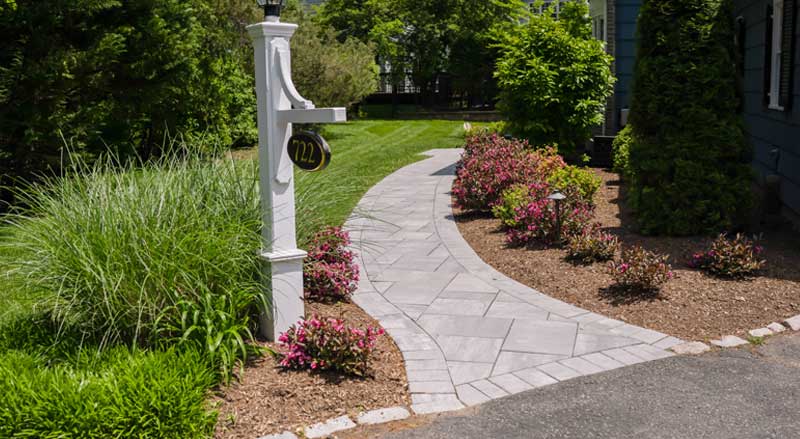Many people love the look of patios built with patio pavers. Not only do they add richness, character, and interest to your hardscaping, but many are eco-friendly. If you’re thinking about creating or upgrading an outdoor living space, you’ll want to consider these patio paver design ideas for your landscape.
Patio Paver Materials
Patio pavers are paving stones that can be fit together like a puzzle to construct an outdoor patio. The slits or small gaps between the pavers make them flexible enough to expand and contract making them much stronger than poured concrete.
Pavers are made of different materials including:
- Brick made from clay
- Concrete
- Natural stone – made from granite, sandstone, marble, etc.
- Porcelain
- Eco-friendly recycled rubber
Patio pavers come in so many different colors, textures, and styles. They give you tremendous flexibility when planning your outdoor living space.
In fact, the function and design possibilities are endless. Take a look at our patio design gallery to get some more ideas.
Patio pavers can upgrade your driveway or create a spectacular outdoor space complete with seating walls and inviting pathways.
In the past, wood, concrete, and stamped concrete were the main options. Today’s paver options open a whole new outdoor design world and have become more popular year after year.

Permeable Pavers
Eco-conscious permeable pavers direct stormwater and snow melt back into the soil to prevent pooling, puddling, and excess runoff.
They are spaced so that stormwater can flow between the gaps and soaks naturally into the soil below. Permeable paving can also include a variety of surfacing techniques for roads, parking lots, and pedestrian walkways.
Some municipalities have stormwater management regulations that restrict the amount of water that can flow from your property.
An experienced landscaper will be aware of any regulations or permit requirements that might affect your patio design idea. They can also determine any drainage or grading solutions that may be necessary.
Patio Pavers Enhance Curb Appeal and Add Value to your Home
Patio pavers are not only functional—they also add value and beauty to your home.
When you use them to update your driveway, you will see your home’s curb appeal soar. Hardscaped areas in your backyard provide sought after outdoor living spaces. Both contribute to higher home value.
Use patio pavers to upgrade your:
- Driveway
- Walkways and garden paths
- Patios and terraces
- Pool deck
- Retaining walls
- Seating walls
- Water features
- Steps and stairs
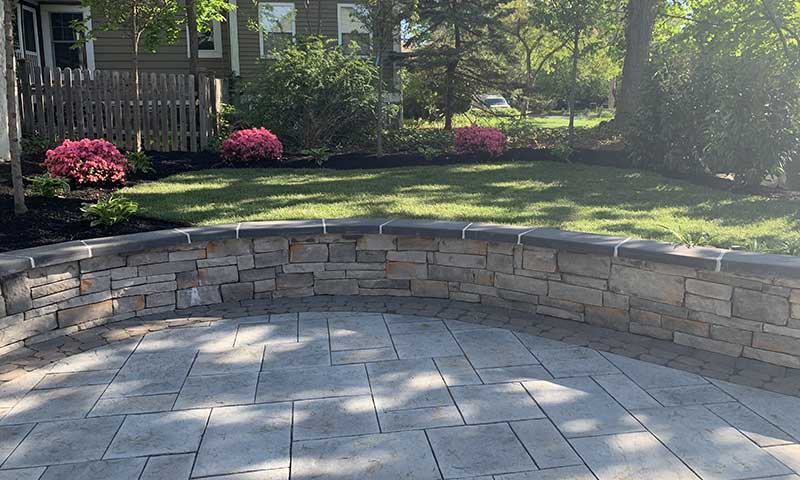
Paver Shapes, Sizes and Textures
Pavers come in many shapes and sizes. Some common shapes include rectangles, squares, and diamonds.
An important design consideration is the paver’s size. Smaller outdoor areas look good with smaller pavers and larger areas can visually carry larger pavers.
Additionally, pavers can be slip-resistant or smooth. This affects not only design but function too.

Paver Patterns
Pavers can be set in distinct patterns including:
- Herringbone
- Stacked bond
- Pinwheel
- Circle
- Diamond
- Chevron mosaic
- Cubic Diamond
- Classic triangles
- Fan
- Basketweave
- Running bond
- Running bond
- Linear
- Chevron
- Cubic
- Geometric
- Checkerboard
- Random
Interesting and coordinating borders will make the overall design appear more intricate.
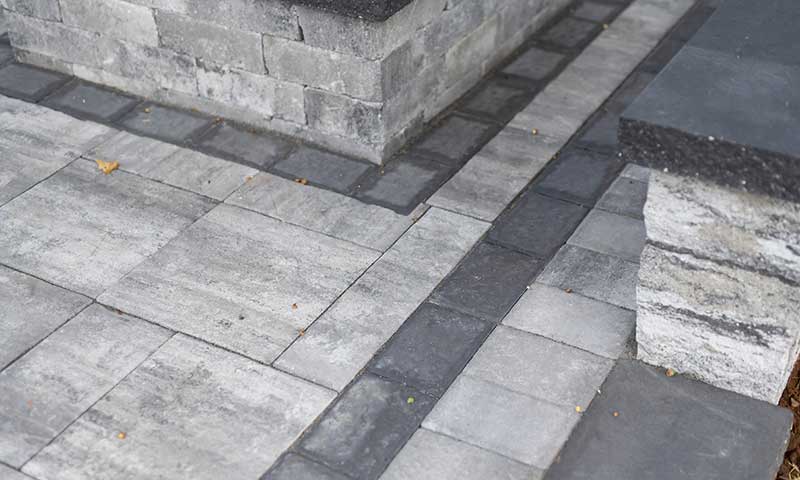
Paver Colors
Patio pavers come in many different colors, including shades of:
- White
- Beige
- Sand
- Red
- Brown
- Gray
- Black
Use several colors to create a pleasing pattern. If you don’t have the best eye for design, consult a landscape design professional. They’re experts at matching paver styles and colors to work perfectly with your home’s aesthetic.
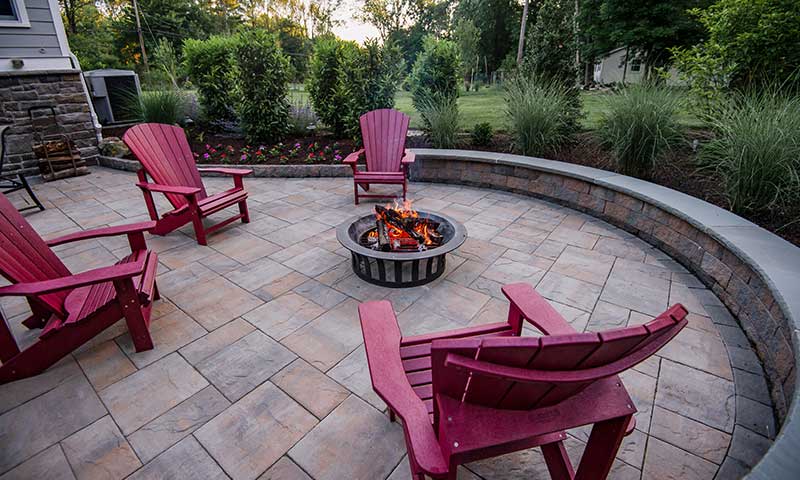
How To Choose The Best Patio Paver Colors for Your Landscape
It’s important to choose the right colors for your patio paver project. Just because you like the look of a certain color, doesn’t mean it will work well with your home.
Many landscape designers agree the best way to choose a paver color is to match it to the color of your home’s roof. This doesn’t mean it has to be a perfect match. Just select paver colors that are close and won’t clash with the roof.
Pavers should also complement your home’s exterior. For instance, red brick homes can use pavers of lighter shades of beige for a pleasing contrast.
If you’re planning a new roof next year, or plan on repainting your home soon, don’t forget to take this into account. Your pavers will be around for many years.
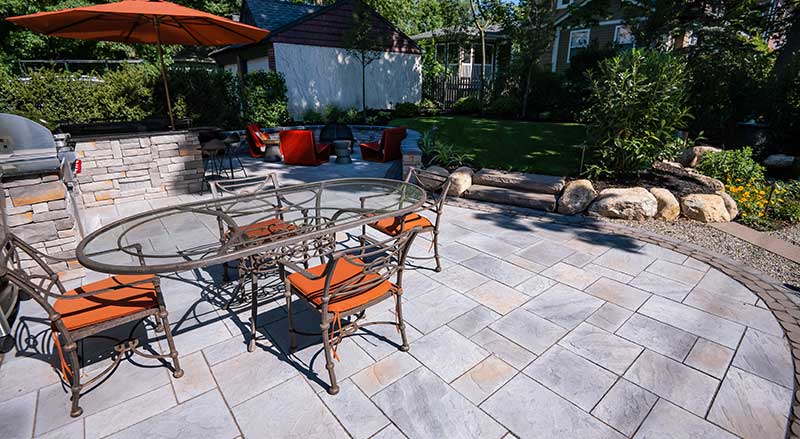
Special Patio Design Tips
Pool Decks and Surrounds
Be sure to use pavers that don’t become too slippery when wet. Think about the way the pavers will feel on bare feet.
Your landscaper can assist in choosing the best type and color for comfortable poolside sitting and walking. Bluestone, travertine, and limestone are often popular choices for pool decks and surrounds.
Also consider the amount of exposure to pool chemicals and the wear and tear from high foot traffic and poolside furniture.
Patios
Use pavers to create interesting patterns. You can even delineate certain areas using color or design. Just make sure all colors and designs work together to create a cohesive and pleasing feel.
Explore the many exciting ways to use patio pavers when installing a multi-level patio. A multi-level patio can have separate dining and entertaining areas and even an outdoor kitchen.
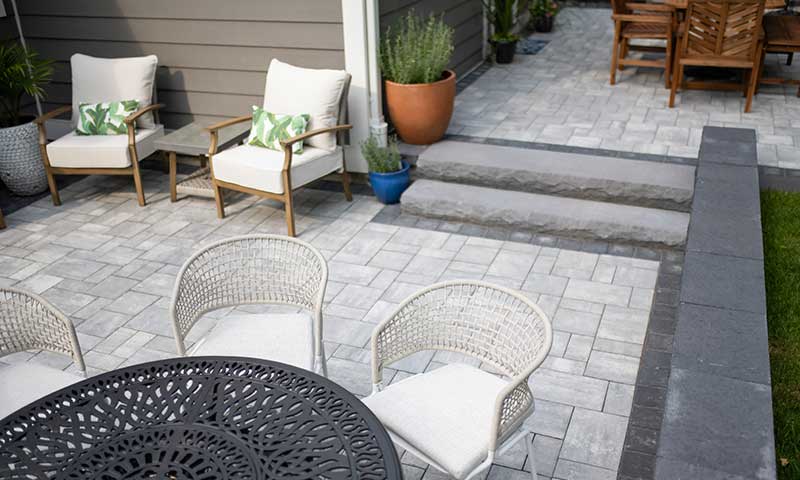
Matching Paver Patios to Walkways
There are a few tricks to match existing pavers to a new walkway or an existing walkway to a new patio. Installers can lift the blocks that were already placed and randomly mix them with the new pavers. Then rebuild the entire area with the randomized mix.
Make sure the old and new pavers are the same thickness or people will be constantly tripping over your uneven patio or walkway.
You will also want to incorporate the old and the new if you are adding walkways or patios next to existing steps and stairs. The most important design goal is to give the entire project a cohesive look, as though it were all created at the same time.
This is the same philosophy as with home architecture—you always want the addition to feel as though it’s part of the original home.
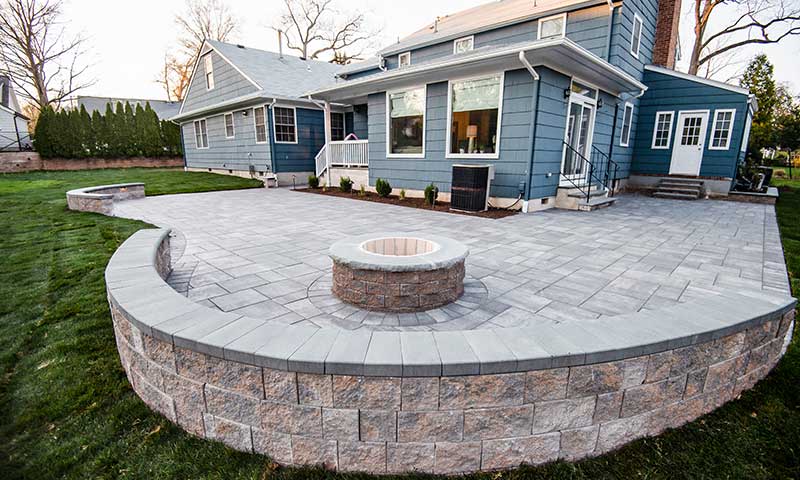
Patio Pavers Are Not Just Beautiful—They’re Durable Too
New Jersey winters can be tough. A concrete patio or pool surround will expand and contract during the many winter freezes and thaws. This causes concrete to crack.
A properly installed paver patio allows pavers to flex and then return to their original positions during winter. This eliminates cracking.
Patio pavers can remain beautiful after years of wear—with some even carrying lifetime warranties.
Techo-Bloc, a top paver manufacturer, has paving stones strong enough to withstand car traffic. Their system of interlocking concrete pavers creates a very strong surface that is perfect for driveways and winter wear. Their pavers are also salt resistant and have color all the way through.
Cambridge is another popular paver brand because of the paver’s strength and ability to retain color.
Patio pavers are low maintenance. Simply sweep surfaces to keep the area free of debris, such as gathering leaves. Read our blog post on “Paver Patio Restoration and Maintenance” for ways to keep patio pavers looking like new.
Also, it’s a good idea to have pavers professionally power washed once a year. This removes dirt, algae, stains, and rust.
Protective sealers can make maintenance easier by making pavers more resistant to stains. Sealers can be invisible on pavers to create a sheen or an always-wet look. To keep pavers in optimal condition, pressure wash yearly and seal them every 3-5 years.
For professional patio paver design and installation, contact Landscape Solutions.

